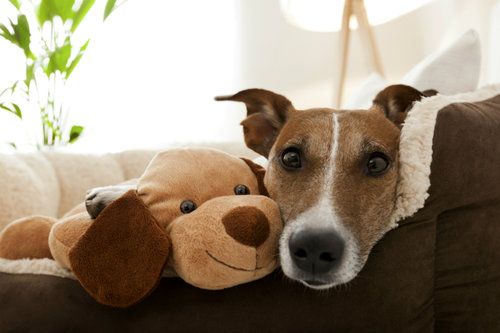Separation Anxiety in Dogs
Introduction
Separation anxiety is a critical behavioral problem, which can cause tremendous emotional distress for both dogs and their owners. It’s not clear why some dogs suffer from anxiety and others don’t, however some research suggest that dogs with a history or abuse or abandonment are more likely to develop separation anxiety. So if you’ve adopted a shelter dog it’s certainly something to keep an eye on.
For a long time many people considered the idea that dogs can suffer from separation anxiety to be a fallacy. How can a pet suffer from the same affliction that people can suffer from?
Surely that must be a myth, right? Wrong! It is a very real problem and is sometimes quite severe. There are two main instances when dogs tend to feel separation anxiety.
Dogs that are being cared for by pet sitters and your own dog when you are away from home. This article will describe separation anxiety symptoms, then it will discuss remedies for those symptoms. We shall talk about remedies for pet sitters, as well as what to do if you are the dog’s owner.
Symptoms and Behavior
At times the best pet sitters may not be able to completely get rid of the anxiety each time you leave your home. There are some mild symptoms to watch out for and remedies for them. These remedies can be applicable to either, the sitter or yourself. What are they?
Whether you are a pet sitter and the owner just left, or if you are a pet parent preparing to leave, there may be visible signs of separation anxiety. The dog will look upset, perhaps shake a little bit. He or she may whimper or bark and display some fear. As a pet sitter you should speak softly to the dog and prepare to show him or her some affection. DO NOT rush at the dog.
Continue to speak softly to it, but allow it to come to you whenever ready. Once the dog does come to you, pet it gently and talk to it in a comforting manner. The purpose for all of this is to demonstrate to the dog that he or she can relax when you are near. The dog will soon realize it has nothing to fear from you and that you are a great substitute for its pet parent.
Just like humans, anxiety occurs when your dog is separated from you or other caregivers in the house. Anxiety-related behavior increases the longer you are away. These behaviors include:
- Whining
- Pacing
- Defecating
- Urinating
- Salvation
- Barking
- Pacing
- Howling
- Hyperactivity
- Scratching
- Chewing
- Digging
Experts agree that separation anxiety is a panic reaction, and definitely not an attempt by the dog to “spite” their owners.
Obviously if you’re away from your dog you won’t be able to spot any of these behaviors.
But if you notice destruction in your home, a pattern of urine or feces in the home when you’re away or neighbors or other caregivers notify you about excessive barking while you’re away those are indications that your dog may be suffering from separation anxiety.
If you are a pet parent and your dog begins to panic when he or she notices you preparing to depart, there are steps you can take as well.
Steps like these are known in the dog world as counter-conditioning. This is a treatment process that teaches the dog to associate pleasant things with you being gone. It is highly recommended by dog behavior specialists. One thing you can do is give your dog a special treat that can take as long as thirty minutes to experience the full pleasure of it.
An example of this is a KONG toy stuffed with low-fat peanut butter. He or she will be so busy enjoying this that it will practically forget you are gone. This method works best if you remove that toy when you return.
The idea being to get the dog to associate that pleasurable experience with you not being there.
Why is Addressing Symptoms Critical?
As with behavior problems of any living being, albeit humans or animals, neglecting it is NOT an option. Even mild dog separation anxiety issues must be addressed or else it will lead to severe issues at some point.
Many dogs wind up in shelters or otherwise abandoned when its symptoms become severe and completely unmanageable. This is usually avoidable by seeking help for your dog.
At different stages of separation anxiety, different treatments become necessary. When do-it-yourself remedies fail to work, please seek a veterinary professional.
This is also important to determine if the root cause is indeed separation anxiety. It could be a medical issue instead. The Internet can be used as a guideline; however, only a trained professional can assess your dog and give you a complete diagnosis.
Signs of More Alarming Separation Anxiety Behavior
Thus far, we have primarily been speaking about mild symptoms. Now we shall get into some more severe signs of separation anxiety in a dog. If you are leaving him or her in the care of a pet sitter, that alone should be enough to prevent these symptoms from occurring. Therefore, this advice is geared towards pet parents.
Endless pacing back and forth by your dog is an example of worsening signs of anxiety. Most of the time this will not happen while you are present. If you suspect this and are concerned, you can install cameras around your home for observation later on.
A camera can also alert you to symptoms such as escape attempts from an enclosed area. If you leave your dog confined while you are gone, it could try to escape when. This can result in damage to itself or parts of your home. It is a good idea to squelch this behavior quickly.
Experts agree that the best way to alleviate symptoms like these is with behavior modification steps. Start with short absences and gradually work your way up to longer and longer ones.
Again, utilize the treat-stuffed toy method to help your dog learn to like your absences. These combined lessons should produce success. Remember it might take time. Do not be angry with your dog if he or she takes more time to adjust.
Severe Separation Anxiety Problems
Now we shall delve into some severe separation anxiety symptoms in your dog. If left untreated, these could become serious problems. In this case, it is possible even the presence of a pet sitter will not deter these actions. Instruct your sitter to alert you if bad behavior occurs when you are gone.
If your dog displays any of these signs, professional help may be needed. It would be wise to consult your veterinarian, he or she can recommend a behavior therapist that specializes in dogs. What are these symptoms? Let’s discuss them now.
In short, these include anything of a destructive nature. It could be literally destroying furniture, clothing, or anything left within its reach. It could be constant barking that irritates your neighbors. It can also involve relieving itself in the house or on your possessions.
Possibly even harming himself or herself in some fashion while you are gone. There is immediate advice available on the Internet from dog behavior experts. You can try these methods first; but do not wait until the consequences become dire to seek professional help. Your dog’s well-being, as well as your sanity, could be at stake.
Statistics
Separation anxiety is the most common behavior issue suffered by dogs. In fact, it’s estimated that 15-35% of all dogs suffer from separation anxiety at some point in their lives. Here are some more interesting facts about separation anxiety in dogs.
- 30-29% of senior dogs have separation anxiety
- 41% of dogs are not treated
- 22% of dogs are treated with behavior modification and drugs
- 10% of dogs are treated with drugs alone
- 17% of dogs are treated with behavior modification alone
Important Tips When a Pet Sitter is Involved
Anytime there will be a new pet sitter in your home while you are away, remember to always have an introduction. This will greatly reduce the amount of separation anxiety your dog will feel when that time comes. He or she should see you interact with the sitter in a positive manner.
Make sure the sitter bonds well with your dog. This may take a little time and should not be rushed. Even when following this advice, your dog still might be afraid when you first depart your home. The pet sitter should be able to make your dog feel at ease and comfortable. In the future, when you leave your dog with this same sitter, he or she will feel very little stress.
Susceptible Dog Breeds
Every dog breed is susceptible to separation anxiety because the triggers are based on psychological issues and experiences. But there are some breeds that are more likely to suffer from separation anxiety.
Treating Separation Anxiety
Separation anxiety is a very common behavioral disorder in dogs. Because dogs with separation anxiety usually exhibit destructive behavior, they tend to be accused of being “bad” or “misbehaving”. In reality, this couldn’t be further from the truth! Dogs with separation anxiety are crying out for help in the only way they know how.
Some typical anxious behaviors include excessive drooling, barking and/or whining, indoor elimination, restlessness, reluctance to eat, and panting/licking lips/pacing. By taking steps to help your dog their overcome separation anxiety, you are making a great effort to give them the happiest life possible.
Start Small
If you suspect that your dog is suffering from separation anxiety, start small. Remember that your dog is emotionally distressed when you leave the house. This can be very taxing on the health of your pet. Leaving for a short period of time and setting up a video camera is a smart way to find out exactly what anxious behavior your dog exhibits while you’re away.
This will help the vet determine the best course of action to help your dog. He or she might need a small dose of anxiety medication to keep them comfortable at first. Separation anxiety can also be a sign of a serious disease, so it’s important to get your dog checked by a veterinarian before trying anything else.
Leaving for a few hours at a time and then gradually increasing the length of your departure is a great way to ease your dog into being separated from you. Try giving your dog something to do while you’re away. Many dogs respond well to something that keeps them busy–a toy stuffed with a treat is a popular choice.
Don’t Make it a Big Deal
It can be very stressful for your dog when he senses that you are about to leave. You can help eliminate some of this stress by preparing for your departure the night before. Keep your shoes, wallet, keys, etc. in one place to avoid running around frantically in the morning.
Instead of making a big deal out of leaving by giving your dog lots of attention, try limiting your interaction with them; gather your things, give them a toy, and leave. When you return, avoid greeting your pet until they have calmed down. Instead of jumping around with your over excited dog, wait until he is relaxed and calm.
This will help your dog realize that departures and arrivals are not a big deal to you.
Examples of Easy and Positive Steps to Take
- Make sure your dog is well-exercised before you leave
- Give him or her the stuffed toy treat five minutes before you leave
- Make departures and returns uneventful. Do not give it kisses and hugs immediately upon return, wait about ten minutes.
- Prepare for your departure in steps. Give your dog some TLC before leaving. Make departing routine and stress-free for him or her
- Do not make departures predictable for the dog. The idea being, he or she will not always know when you are leaving, reducing stress build-up
Leave an Article of Clothing
It is important that your dog has a safe space, such as a crate or bed, where he or she can feel comfortable while you’re away. Crates have been shown to reduce anxiety in dogs by giving them the feeling of having their own private “den.” Be sure they have access to any comfort objects, such as a special toy or blanket, before you leave.
Because dogs heavily associate your scent with you, it might help to leave an article of your clothing in their bed for reassurance. Your scent will hopefully keep them calm and relaxed.
Tire Them Out!
Many dogs have an abundance of energy that only worsens their separation anxiety. Helping your dog expend some of that energy will reduce their anxiety and help them relax before you leave. If you leave for work early in the morning, wake up an hour earlier to take your dog on a long walk.
If you’re leaving in the afternoon, try taking your dog to the dog park for a long playdate! When you return home, your dog is likely to need a nap, making it less likely that he or she will panic when it’s time for you to go.
Most people expect their dogs to be fine at home while they are at work all day, but unfortunately this is unrealistic for many pets. Your dog does not know you have to go to work; he just wants to be with you! Taking a few days off from work in order to help improve your dog’s behavior is a wonderful investment in their health and overall quality of life.
Medications
Depending on the severity of your dog’s separation anxiety the two most common courses of treatment are medications and/or behavior modification (a fancy word for training). Medications include clomipramine and fluoxetine: These are approved medications for the treatment of separation anxiety that can be prescribed by your veterinarian.
Since these medications may take several weeks to achieve effective levels, short-acting drugs such as alprazolam may be prescribed at first. Any anti-anxiety drug prescribed by your veterinarian needs to be given exactly as directed.Aside from behavior modification training and medication, some dog owners have a lot of success with body-wraps that can help your dog self-sooth. The most popular and trusted such wrap is the ThunderShirt dog anxiety vest, which retails for $39.95.
Cost of Treatment
Medication can cost between $20 per month for generic brands and $30-40 per month for name brand meds.
Personal Experience
Our dog Beau suffered from separation anxiety for years. He was a rescue and never fully recovered from some of the traumatic issues early in his life. The good news is that with the help of anxiety medication he was able to adjust when we were away. No dog owner wants their pet to suffer while they’re gone, so if you suspect your dog has issues with separation anxiety visit your veterinarian and explore ways to manage the problems. It will make for a happier dog and might save you the headache from ripped-up pillows and carpet stains!
Pet Insurance for Behavioral Coverage
There are several great insurance options that will cover treatment for separation anxiety. Keep in mind though that pet insurance policies do NOT cover pre-existing conditions so make sure you have coverage before your dog is diagnosed with separation anxiety.
Will Getting a Second Dog Help?
Advocates of this theory are certain that their dog is lonesome and that adding a second one will solve the problem. The experts say this is not necessarily true. It may alleviate the problem in some dogs but not others. The experts collectively agree that getting a second dog does not address the fears of the first dog.
Once he or she gets used to having a new dog around, the separation anxiety symptoms return and could be worse. It remains important to seek the advice of dog professionals for appropriate treatment.
The Most Important Advice We Can Give You
We touched upon this earlier, but wish to reiterate it now. The most important step you can take to combat separation anxiety in your dog is to address it right away. Do not sit back and hope it corrects itself, because it will not. There are numerous ways to do something about it yourself. There are scores of professionals who can assist you every step of the way.
As animal lovers, we are horrified about all of the dogs that get abandoned. Odds are good that a lot of that has to do with neglectful treatment of separation anxiety symptoms. If these pet parents had sought the proper help, perhaps far less dogs would have suffered this fate. Please, if your dog has signs of separation anxiety, seek help immediately. Thank you in advance.
Helpful Reference Materials
There are some books you can read to see if you can resolve the problem without help. “I’ll Be Home Soon” by Patricia McConnell is excellent. So is “Clinical Behavioral Medicine for Small Animals” by Dr. Karen Overall.
Any advice you can find from world-renowned dog behavior expert, Cesar Millan, will be of considerable help to you. Aka the Dog Whisperer, Mr. Millan has online materials you can reference. There are times he takes his teachings on the road and will come to a city or town near you.Visit his website to see if and when he will be coming.
Related Content





















